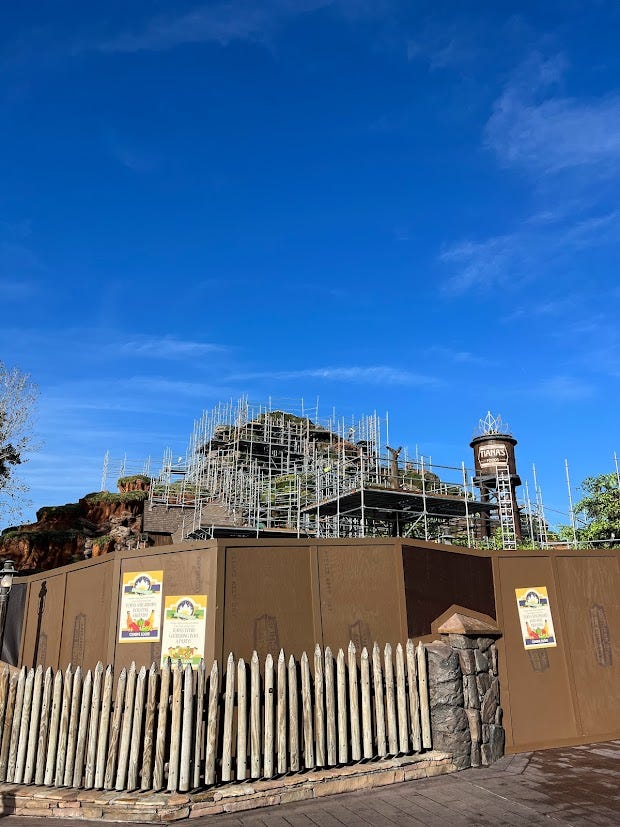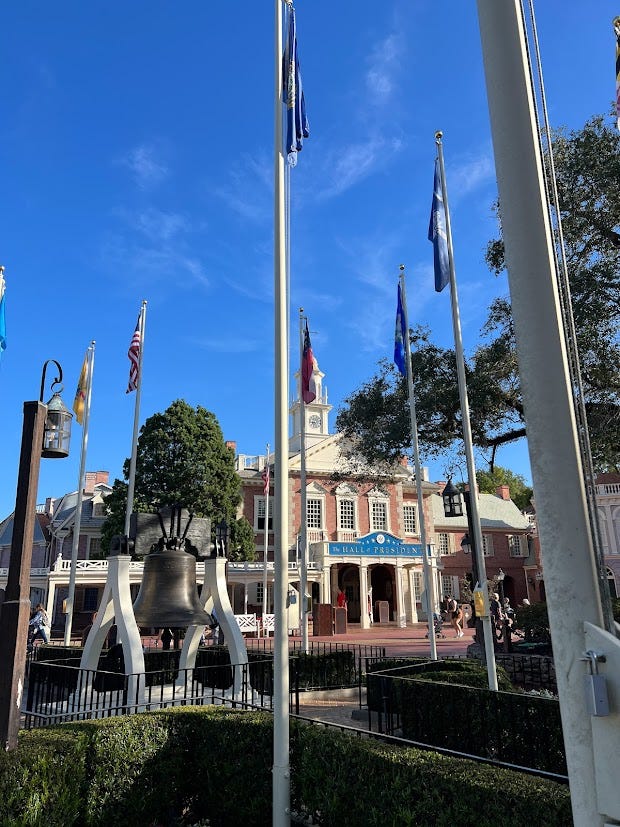Walt Disney World, Florida, and the Frontier
What to early American history is Florida anyway?
I took a quick trip back home to Florida last week to go to Walt Disney World. Part of this is because I had purchased season passes last year and I didn’t want to waste them. I also wanted to get home for a quick breather before the colder Colorado winter sets in. Despite all of its problems, Florida is still home. And so off I went.
All four parks were on the docket for the trip and Friday meant it was time for Magic Kingdom. While EPCOT is my sentimental favorite because I worked there during my time in the College Program back in ‘98, there’s always something magical about visiting Magic Kingdom. MK is host to a lot of my favorites, including Carousel of Progress, the Haunted Mansion, and recently, the Hall of Presidents. But this trip I was thinking more and more about how Walt Disney World memorializes the American past, and specifically early American history.
Naturally, much of this takes place in Frontierland, home of Big Thunder Mountain, the Haunted Mansion, and Country Bear Jamboree. It’s also home to the former Splash Mountain, which was my favorite attraction, but I’m eager to see it reemerge as Tiana’s Bayou Adventure late next year. I snapped a picture of it in progress, which you can see here:
There’s a lot to see in Frontierland. One of my favorite areas is in Liberty Tree Square, where you used to be able to catch a cool Revolutionary era skit by the Muppets, as well as dine at maybe my favorite restaurant in all of Walt Disney World, the Liberty Tree Tavern. The block hosts the Hall of Presidents, which is really, really good (go see it), as well as a replica of the Liberty Bell, meaning you can see this American icon without actually having to go to Philadelphia or worry about getting scabies.
However, just like reading maps, often times what we learn most is by seeing what is not there. In this case, Florida. Walking around the park, Florida is not represented in Frontierland, and rarely anywhere else. The closest we come is a mythical story about the “discovery” of Disney Springs by South Carolina settlers in the 19th century, or the Grand Floridian Resort, which mimicks the boardwalk resorts of a century later.1 In my mind it is an omission that speaks volumes about how we think about the American past and Florida’s place in it.
One of the things I tell my students is that none of the European empires quite knew what to do with Florida. They all coveted it, but none of them seemed to understand it or how to benefit from it, which helps to explain why it was traded back and forth so often. I don’t know that historians have really figured out Florida, either.
Broadly speaking, the history of the United States is still generally taught as an east-west narrative dominated by the British experience, though scholars such as Ned Blackhawk are working hard to challenge these ideas through stories that are centered elsewhere. Certainly French history is important, especially in Louisiana, where descendants of French-speaking Canadians resettled in the 18th century, becoming known as Cajuns. The experiences of enslaved Africans are still being grappled with, with the 1619 Project recently garnering much deserved attention.
But what of Florida? I was recently asked of what I contribute to the historiography and all I could think under my breath was what historiography? You’d think being the third-most populous state and boasting a correspondingly large 30 electoral votes, we’d work harder to understand this space. And yet, Florida seems to remain an afterthought in the American historical imagination, at least from what I can see.2
What is this place?
I don’t know that we really know, but that’s not stopping others. One of the things my book is about is how cattle change Florida and the relationships between people, the landscape, and each other in the 18th and 19th centuries. While Spanish colonists brought the animals to Florida, it was really Indigenous people who did most of the labor around them early on. Later, recently self-emancipated people of African descent also moved to Florida and worked the animals. A final group, poor white settlers from Georgia and South Carolina called Florida Crackers moved in shortly thereafter and the scene was set for decades of violent conflict.
If you visit those spaces today, you’ll see the Florida Cracker Trading Company located in Brooksville, on the lands where Seminoles first worked those animals over two centuries ago. The company is a lifestyle apparel company, much in the same way that you might find fishing apparel companies near the coast. But FCTC does something different, selling an imagined Florida history to willing buyers. Their logo boasts an inverted boot in place of Florida, with the phrase “The Original Floridian” and the year 1521. Crackers, the company tells us, are the real Floridians, and only heirs to its cattle tradition. Native people are, sadly, erased from this tradition. (1521, of course, being the year that actual Floridians, Calusas, sent Ponce de Leon’s colonizing ass back to Cuba with an arrow in his thigh. But let’s not let that get in the way.) What we do see here, is that in Florida, early history is being written by lifestyle companies and quite literally worn on the sleeves of its citizenry.3
Now I can’t spoil the book- someone has to buy it eventually- but there are some interesting things at play here. I read today of The Grow- a $1B real estate venture east of Orlando is now under development. Marketed as Florida’s first “agrihood” where “signature amenities include a working farm, stunning barns, and miles and miles of pathways leading to new traditions that cultivate connections between neighbors and the land,” real estate developers have seized upon an idealized version of Florida’s past to sell people on interior land now that the seaboards are all but developed. The Grow is not alone; another developer just launched plans for a 1,435-acre project of 1,999 homes near the Econolockhatchee River. More will come and how they market their projects will tell us more about how people are choosing to remember Florida.
Disney, meanwhile, is also building, though they those to construct their new town in North Carolina.
In the meantime, I’ll write more here as I can about Florida and American memory in general. But if you have a favorite book on the state, let me know in the comments below.
Thanks to Evan Nooe for tipping me off on this.
There are, fortunately, a number of recent works about Indigenous Florida during the era, from some outstanding scholars such as Alejandra Dubcovsky, Andrew Frank, Evan Nooe, Denise Bossy, and others.
This isn’t the only case of this going around. Kristalyn Shefveland has an upcoming book next year about how boosters used a mythologized past to sell potential settlers on the town of Vero Beach in the 19th and 20th centuries. https://a.co/d/h4y8fiw







Chadd Scott and I try to cover all aspects of Florida's history and culture on our podcast, "Welcome to Florida," with episodes on the Castillo de San Marcos, the Kingsley Plantation, the Seminole Wars, Harriet Beecher Stowe, pirates etc. Incidentally, we had Jason Vuic on to talk about "The Swamp Peddlers." https://www.buzzsprout.com/1169570
When we moved from North Carolina to Spring Hill, Fl, 63.2sqm of suburb, I bought *The Swamp Peddlers: How Lot Sellers, Land Scammers, and Retirees Built Modern Florida and Transformed the American Dream,* by Jason Vuic. Eye opening modern history of central Florida. Also depressing. Thx for the h/t to Brooksville, nice small town county seat, in spite of the rebel jockey on the courthouse lawn. Being a Virginian who grew up halfway between DC and Richmond, I couldn’t believe Florida could have any Civil War history. But they’re inordinately proud of the little bit they have. Smh.